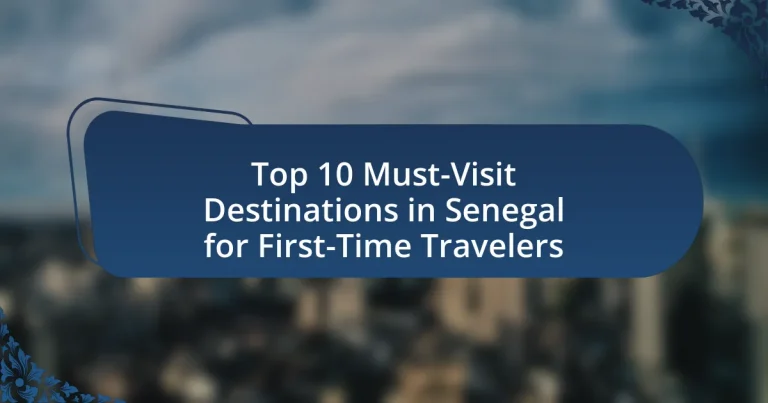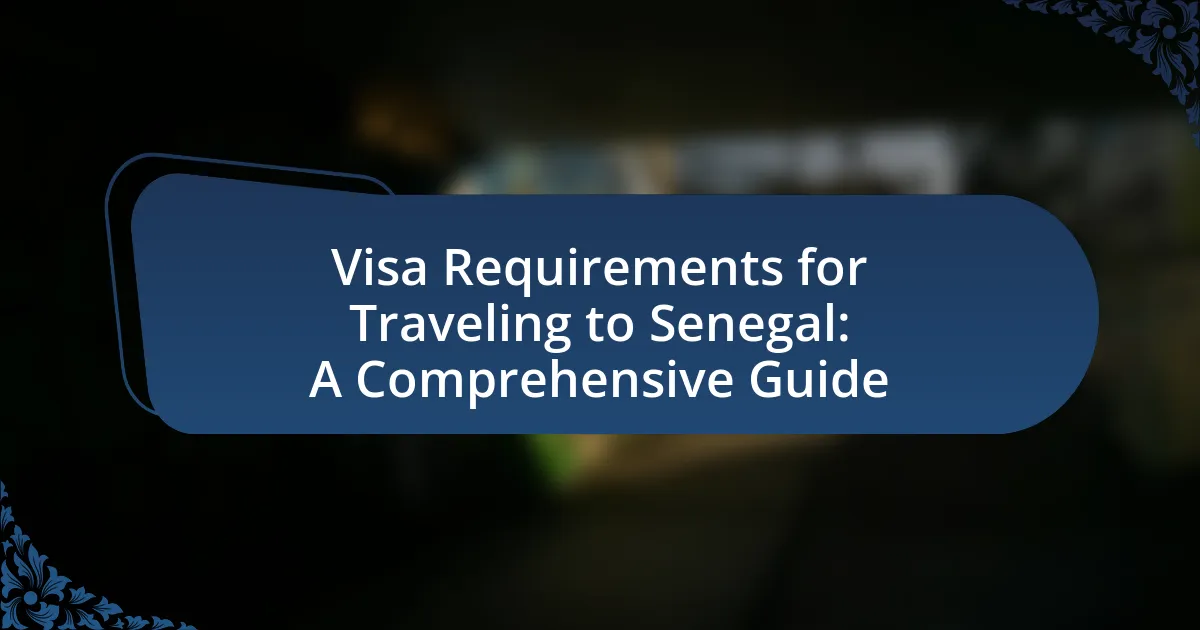The article focuses on the top 10 must-visit destinations in Senegal for first-time travelers, highlighting key locations such as Dakar, Gorée Island, Lake Retba, and Niokolo-Koba National Park. It provides insights into the cultural significance, natural beauty, and unique experiences each destination offers, including historical landmarks, wildlife viewing, and local cuisine. Additionally, the article discusses the appeal of Senegal as a travel destination, emphasizing its rich cultural heritage, diverse landscapes, and welcoming atmosphere, while also offering practical tips for navigating transportation and engaging with local customs.
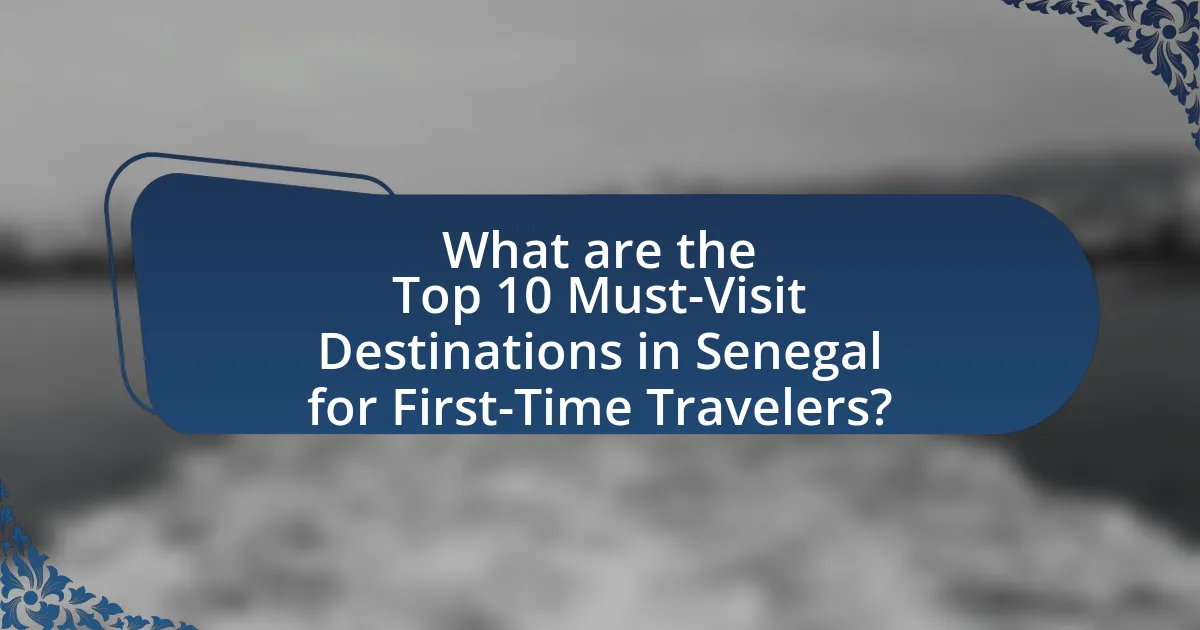
What are the Top 10 Must-Visit Destinations in Senegal for First-Time Travelers?
The top 10 must-visit destinations in Senegal for first-time travelers are Dakar, Gorée Island, Lake Retba, Niokolo-Koba National Park, Saint-Louis, the Pink Lake, Bandia Wildlife Reserve, Casamance, Toubakouta, and the Saloum Delta.
Dakar, the capital city, offers vibrant culture and historical sites, including the African Renaissance Monument. Gorée Island is known for its historical significance in the slave trade, featuring the House of Slaves. Lake Retba, or Lac Rose, is famous for its pink waters due to high salt content. Niokolo-Koba National Park is a UNESCO World Heritage site, home to diverse wildlife and ecosystems. Saint-Louis, a former colonial capital, showcases French colonial architecture and a rich cultural scene. The Pink Lake attracts visitors for its unique color and salt harvesting. Bandia Wildlife Reserve allows for wildlife viewing, including zebras and giraffes. Casamance is known for its lush landscapes and traditional villages. Toubakouta offers a serene environment with access to the Saloum Delta, a UNESCO Biosphere Reserve known for its biodiversity and mangroves. The Saloum Delta is also recognized for its rich birdlife and fishing opportunities.
Why is Senegal a popular destination for first-time travelers?
Senegal is a popular destination for first-time travelers due to its rich cultural heritage, diverse landscapes, and welcoming atmosphere. The country offers unique experiences such as visiting the historic island of Gorée, known for its significance in the transatlantic slave trade, and exploring the vibrant capital city of Dakar, which is a hub for music and art. Additionally, Senegal’s national parks, like Niokolo-Koba, provide opportunities for wildlife viewing, while the stunning beaches of Saly and Cap Skirring attract those seeking relaxation. The combination of these attractions, along with the country’s reputation for hospitality, makes Senegal an appealing choice for newcomers to travel.
What unique cultural experiences does Senegal offer?
Senegal offers unique cultural experiences such as vibrant music and dance, particularly through the traditional rhythms of sabar and mbalax, which are integral to Senegalese celebrations and gatherings. The country is also known for its rich culinary heritage, featuring dishes like thieboudienne, a fish and rice dish that reflects the coastal culture. Additionally, Senegal’s historical sites, such as Gorée Island, provide insight into the transatlantic slave trade, while the annual Dakar Biennale showcases contemporary African art, emphasizing the nation’s artistic contributions. These experiences highlight Senegal’s diverse cultural landscape, rooted in its history, traditions, and artistic expressions.
How does Senegal’s geography enhance its appeal?
Senegal’s geography enhances its appeal through its diverse landscapes, which include coastal areas, savannas, and wetlands. The country boasts a long Atlantic coastline of approximately 531 kilometers, offering beautiful beaches and vibrant marine life that attract tourists. Additionally, the Senegal River, which forms part of the border with Mauritania, provides fertile land and supports rich biodiversity, making it a key area for eco-tourism. The unique geography also includes the Sahel region, characterized by its semi-arid climate, which supports distinct flora and fauna, further enriching the travel experience. These geographical features collectively create a variety of attractions that cater to different interests, from beachgoers to nature enthusiasts.
What criteria were used to select these top destinations?
The criteria used to select the top destinations in Senegal for first-time travelers include cultural significance, accessibility, natural beauty, and visitor reviews. Cultural significance is assessed by the historical and social importance of each location, such as Gorée Island’s role in the transatlantic slave trade. Accessibility is evaluated based on transportation options and ease of travel for tourists. Natural beauty is considered through the evaluation of landscapes and wildlife, exemplified by the stunning beaches of Saly. Visitor reviews provide insights into the experiences of previous travelers, highlighting popular attractions like Dakar’s vibrant markets and the unique landscapes of the Pink Lake.
How do tourist attractions differ in terms of historical significance?
Tourist attractions differ in terms of historical significance based on their cultural heritage, events they commemorate, and their role in shaping national identity. For instance, the Island of Gorée is significant for its history related to the transatlantic slave trade, serving as a poignant reminder of this dark chapter in history. In contrast, the Great Mosque of Touba represents the spiritual and cultural identity of the Mouride Brotherhood, highlighting the importance of religion in Senegalese society. Each attraction’s historical context and the narratives they convey contribute to their unique significance, influencing how they are perceived and valued by both locals and visitors.
What role does natural beauty play in the selection of these destinations?
Natural beauty significantly influences the selection of destinations in Senegal, as it attracts travelers seeking picturesque landscapes and unique ecosystems. The diverse natural features, such as the stunning beaches of Dakar, the lush greenery of Niokolo-Koba National Park, and the striking pink waters of Lake Retba, enhance the appeal of these locations. These natural attractions not only provide aesthetic enjoyment but also offer opportunities for activities like hiking, birdwatching, and photography, making them essential factors in travel decisions.
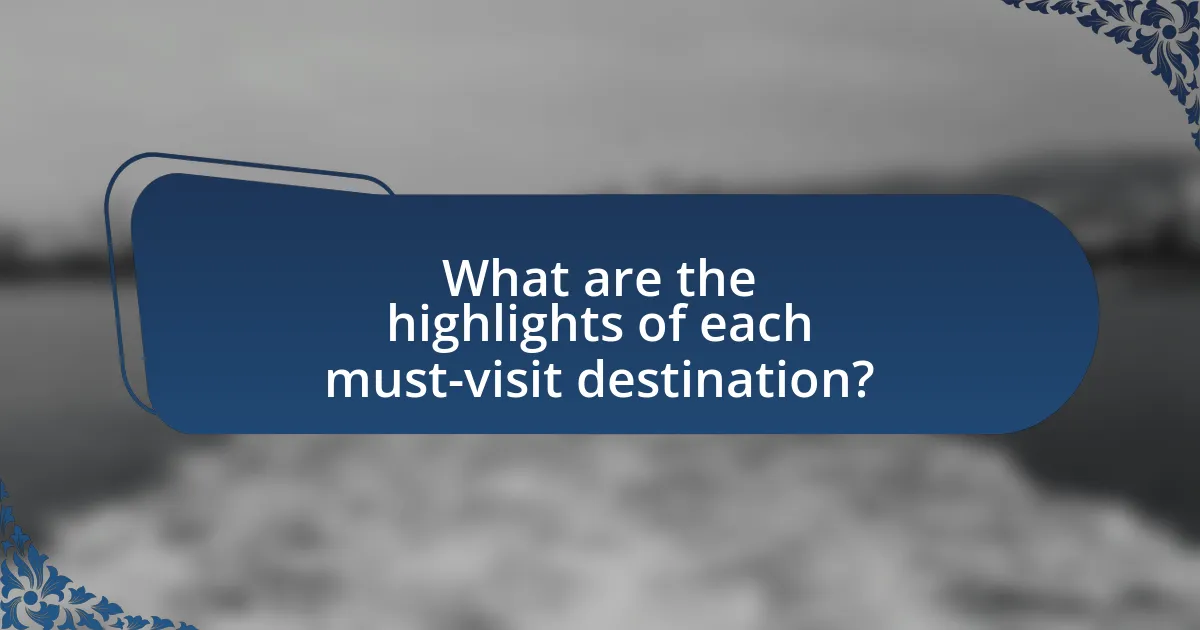
What are the highlights of each must-visit destination?
The highlights of each must-visit destination in Senegal include diverse cultural experiences, historical significance, and natural beauty.
-
Dakar: The capital city is known for its vibrant arts scene, bustling markets, and the iconic African Renaissance Monument, which stands at 49 meters tall and symbolizes African independence.
-
Gorée Island: This UNESCO World Heritage site is famous for its historical significance in the transatlantic slave trade, with the House of Slaves museum providing poignant insights into this dark chapter of history.
-
Lake Retba (Lac Rose): Renowned for its striking pink waters caused by high salt content and algae, Lake Retba is a unique natural phenomenon that attracts photographers and tourists alike.
-
Niokolo-Koba National Park: A UNESCO World Heritage site, this park is home to diverse wildlife, including elephants, lions, and various bird species, making it a prime destination for eco-tourism and wildlife enthusiasts.
-
Saint-Louis: Known for its colonial architecture and vibrant cultural festivals, Saint-Louis is a UNESCO World Heritage site that showcases the blend of African and European influences.
-
Sine-Saloum Delta: This biosphere reserve is celebrated for its rich biodiversity, mangrove forests, and traditional fishing villages, offering opportunities for eco-tourism and cultural immersion.
-
Toubkal National Park: Famous for its stunning landscapes and hiking trails, this park is ideal for adventure seekers looking to explore Senegal’s natural beauty.
-
Casamance: This region is known for its lush greenery, beautiful beaches, and rich cultural heritage, including traditional music and dance.
-
Pink Lake: Similar to Lake Retba, Pink Lake is another natural wonder with its vibrant pink hue, attracting visitors for its unique beauty and salt harvesting activities.
-
Bandia Reserve: This wildlife reserve is home to various species, including rhinoceroses and zebras, providing a safari experience close to Dakar.
Each destination offers unique highlights that reflect Senegal’s rich cultural heritage and natural wonders.
What makes Dakar a vibrant starting point for travelers?
Dakar is a vibrant starting point for travelers due to its rich cultural heritage, diverse attractions, and strategic location. The city boasts landmarks such as the African Renaissance Monument, which stands at 49 meters and symbolizes African independence, and the historic Gorée Island, a UNESCO World Heritage site known for its role in the transatlantic slave trade. Additionally, Dakar serves as a gateway to explore the natural beauty of Senegal, including the pink waters of Lake Retba and the wildlife of Niokolo-Koba National Park. The city’s bustling markets, vibrant music scene, and culinary diversity further enhance its appeal, making it an essential hub for first-time visitors to Senegal.
What cultural landmarks should be visited in Dakar?
The cultural landmarks that should be visited in Dakar include the African Renaissance Monument, Gorée Island, and the Dakar Grand Mosque. The African Renaissance Monument, standing at 49 meters, is the tallest statue in Africa and symbolizes Senegal’s independence and progress. Gorée Island, a UNESCO World Heritage site, is significant for its history as a slave trading post and features the House of Slaves museum, which provides insight into the transatlantic slave trade. The Dakar Grand Mosque, completed in 1964, is one of the largest mosques in West Africa and showcases stunning architecture, reflecting the Islamic heritage of the region.
How does Dakar’s nightlife contribute to its allure?
Dakar’s nightlife significantly enhances its allure by offering a vibrant mix of cultural experiences, music, and social interactions. The city is renowned for its lively music scene, particularly in genres like mbalax, which draws both locals and tourists to venues such as clubs and bars. Additionally, Dakar hosts numerous festivals and events that showcase local talent, creating an engaging atmosphere that reflects the city’s rich cultural heritage. The presence of diverse dining options, from street food to upscale restaurants, further enriches the nightlife experience, making it a hub for culinary exploration. This combination of music, culture, and gastronomy contributes to Dakar’s reputation as a dynamic destination for nightlife enthusiasts.
Why is Gorée Island significant for visitors?
Gorée Island is significant for visitors due to its historical role in the transatlantic slave trade, serving as a poignant reminder of the suffering endured by enslaved Africans. The island is home to the Maison des Esclaves (House of Slaves), which was a major departure point for enslaved individuals shipped to the Americas. This UNESCO World Heritage site attracts visitors seeking to understand the impact of slavery on African history and culture. The island’s museums and memorials provide educational insights, making it a crucial destination for those interested in human rights and historical awareness.
What historical events are commemorated on Gorée Island?
Gorée Island commemorates the transatlantic slave trade, specifically the suffering and displacement of enslaved Africans. This historical significance is marked by the House of Slaves, which served as a holding place for enslaved individuals before their forced departure to the Americas. The island also honors the memory of those who endured this brutal chapter in history, with memorials and museums dedicated to educating visitors about the impact of slavery on African communities and the diaspora.
How can visitors engage with the local community on Gorée Island?
Visitors can engage with the local community on Gorée Island by participating in cultural tours, attending local events, and supporting local artisans. Cultural tours often include guided visits to historical sites, such as the House of Slaves, where visitors can learn about the island’s history and its significance in the transatlantic slave trade. Attending local events, such as festivals or markets, allows visitors to experience traditional music, dance, and cuisine, fostering direct interaction with residents. Additionally, purchasing handmade crafts and artworks from local artisans not only supports the community economically but also provides visitors with authentic souvenirs that reflect the island’s culture.
What natural wonders can be found in Niokolo-Koba National Park?
Niokolo-Koba National Park is home to diverse natural wonders, including savannas, forests, and rivers. The park features the Gambia River, which supports a rich ecosystem, and is known for its significant biodiversity, including endangered species like the West African lion and the African elephant. Additionally, the park’s varied landscapes provide habitats for numerous bird species, making it a vital area for wildlife conservation.
What wildlife can travelers expect to see in Niokolo-Koba?
Travelers can expect to see a diverse range of wildlife in Niokolo-Koba National Park, including elephants, lions, leopards, and various species of antelope such as the kob and the bushbuck. The park is also home to over 300 bird species, making it a significant site for birdwatching. Niokolo-Koba is recognized as a UNESCO World Heritage Site, which underscores its ecological importance and the variety of habitats that support these species.
How can visitors best experience the park’s biodiversity?
Visitors can best experience the park’s biodiversity by participating in guided nature walks and wildlife tours. These activities allow visitors to observe various species in their natural habitats, enhancing their understanding of the ecosystem. For instance, guided tours often provide insights into the unique flora and fauna, including endemic species that are crucial to the park’s biodiversity. Engaging with knowledgeable guides can also enrich the experience by offering educational context about conservation efforts and the ecological significance of the area.
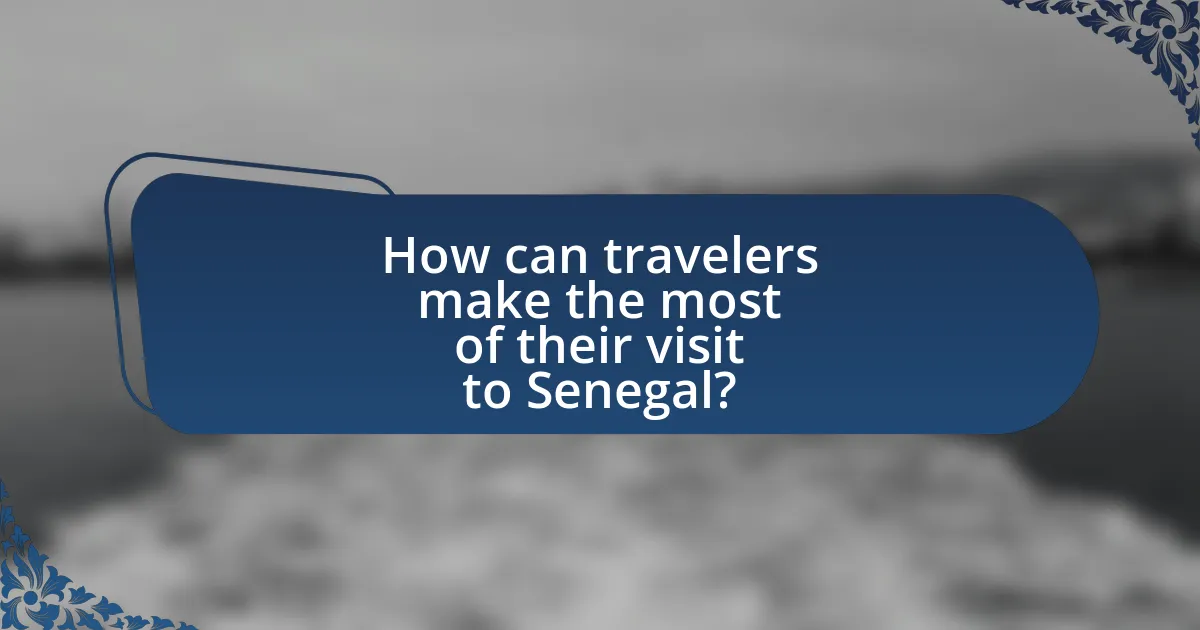
How can travelers make the most of their visit to Senegal?
Travelers can make the most of their visit to Senegal by exploring its diverse cultural heritage, engaging with local communities, and visiting key attractions. Key activities include visiting Dakar’s vibrant markets, experiencing the historical significance of Gorée Island, and enjoying the natural beauty of Niokolo-Koba National Park. Engaging with local cuisine, such as trying traditional dishes like thieboudienne, enhances the cultural experience. Additionally, participating in local festivals, such as the Dakar Biennale, provides insight into Senegalese art and culture. These activities allow travelers to immerse themselves in the rich traditions and landscapes of Senegal, ensuring a memorable visit.
What practical tips should first-time travelers keep in mind?
First-time travelers should prioritize planning their itinerary and understanding local customs. Researching destinations in Senegal, such as Dakar and Gorée Island, helps in maximizing the travel experience. Familiarizing oneself with cultural norms, such as greetings and dress codes, enhances interactions with locals. Additionally, keeping essential documents, like passports and travel insurance, organized and accessible is crucial for smooth travel. Staying aware of health precautions, such as vaccinations and safe drinking water, is also important for well-being during the trip.
How can travelers navigate transportation options in Senegal?
Travelers can navigate transportation options in Senegal by utilizing a combination of taxis, buses, and car rentals. Taxis are widely available in urban areas, with both traditional and ride-hailing services like Yango and Uber operating in Dakar. Buses, including the popular “car rapide,” offer affordable travel between cities and within urban areas, though they can be crowded and less reliable. For more flexibility, travelers can rent cars from various agencies, but should be aware of local driving conditions and traffic rules. According to the World Bank, Senegal has been improving its transportation infrastructure, making it easier for travelers to access key destinations.
What are the best times of year to visit Senegal for optimal experiences?
The best times of year to visit Senegal for optimal experiences are from November to February. During this period, the weather is cooler and drier, making it ideal for outdoor activities and exploration. Specifically, average temperatures range from 20°C to 30°C, and rainfall is minimal, allowing visitors to enjoy attractions like Dakar, Gorée Island, and the Pink Lake without the discomfort of excessive heat or humidity. This season also coincides with various cultural festivals, enhancing the travel experience.
What cultural etiquette should travelers be aware of?
Travelers in Senegal should be aware of the importance of greetings and respect for local customs. In Senegalese culture, greeting people is a vital part of social interaction; it is customary to greet everyone you encounter, often with a handshake or a nod, before engaging in conversation. Additionally, modest dress is encouraged, especially in rural areas, to show respect for local traditions. Observing these practices fosters goodwill and enhances the travel experience, as they reflect the values of hospitality and community that are central to Senegalese society.
How can understanding local customs enhance the travel experience?
Understanding local customs enhances the travel experience by fostering deeper connections with the culture and people of the destination. When travelers are aware of local traditions, etiquette, and social norms, they can engage more meaningfully with residents, which often leads to authentic interactions and enriched experiences. For instance, in Senegal, knowing the importance of greetings and the practice of sharing meals can create a welcoming atmosphere and open doors to local friendships. Studies show that cultural understanding can significantly increase satisfaction and enjoyment during travel, as it allows for a more immersive experience that respects and appreciates the host culture.
What are common phrases in Wolof that travelers should learn?
Common phrases in Wolof that travelers should learn include “Nanga def?” which means “How are you?”, “Jërëjëf” for “Thank you”, and “Ba beneen yoon” meaning “See you later.” These phrases are essential for basic communication and show respect for the local culture. Learning these expressions can enhance interactions with locals, as Wolof is widely spoken in Senegal, making it a valuable tool for travelers.
What are the must-try local dishes for first-time visitors?
First-time visitors to Senegal should try Thieboudienne, a traditional fish and rice dish considered the national dish, made with marinated fish, vegetables, and a flavorful tomato sauce. Another must-try is Yassa, which features marinated chicken or fish cooked with onions and lemon, offering a tangy taste. Additionally, visitors should sample Mafé, a rich peanut stew that can include meat or vegetables, showcasing Senegal’s culinary diversity. These dishes reflect the country’s cultural heritage and are widely enjoyed by locals, making them essential for an authentic culinary experience.
How does Senegalese cuisine reflect the country’s cultural diversity?
Senegalese cuisine reflects the country’s cultural diversity through its incorporation of various ethnic influences, including Wolof, Serer, and Lebou traditions. The use of staple ingredients like rice, fish, and vegetables showcases the coastal and agricultural heritage of Senegal, while dishes such as thieboudienne (fish and rice) and yassa (marinated chicken or fish) highlight the blending of flavors and cooking techniques from different cultures. Additionally, the presence of spices and cooking methods from North African and French colonial influences further enriches the culinary landscape, making it a vibrant representation of Senegal’s multicultural identity.
What are the best places to sample traditional Senegalese food?
The best places to sample traditional Senegalese food include Le Lagon, which is renowned for its authentic dishes and waterfront views, and Chez Loutcha, famous for its traditional Senegalese thieboudienne. Additionally, La Fourchette offers a diverse menu featuring local specialties, while the vibrant markets of Dakar, such as Marché Sandaga, provide an immersive experience with street food options. These locations are celebrated for their commitment to traditional recipes and ingredients, making them ideal for experiencing the rich culinary heritage of Senegal.
